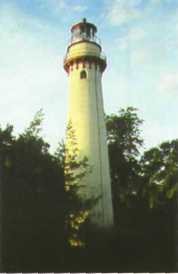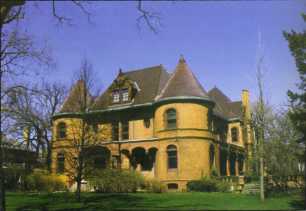 |
Home | Search | Browse | About IPO | Staff | Links |
 |
Home | Search | Browse | About IPO | Staff | Links |
|
105th Annual Meeting in Evanston, April 29-30  Grosse Point Lighthouse in Evanston. Photo courtesy D.J. Terras. By David W. Scott "Evanston and It Neighbors" will be the theme of this year's annual meeting of the Illinois State Historical Society. It will be one members should not want to pass up. The DoubleTree Hotel in suburban Skokie will be the headquarters for the events on Friday and Saturday, April 29 and 30. The tours on Friday morning and afternoon and on Saturday morning will be in keeping with the theme of seeing a given locality in its larger setting. All Day Tour of Evanston  The Charles Gates Dawes home in Evanston. Photo courtesy Evanston Historical Society. Harding, he was the first director of the Bureau of the Budget; under Coolidge, he was Vice-President; and, under Hoover, headed the Reconstruction Finance Corporation. He was also a lawyer, Chicago bank president, and musician. He had been the Comptroller of the Currency under President McKinley. He was positioned to compete for the Republican nomination for the President in 1920 and in 1928, but circumstances favored others. He died in 1951. A Dawes impersonator will join the group for lunch. 20 Illinois Heritage alcohol. Some called it Heavenston. However, as the 20th century wore on the city became increasingly diverse socio-economically, ethnically, and racially and in its housing types and condition. The tours will show this diversity. The Friday afternoon bus tour and several short walking tours will include the lakeshore historic district with its late 19th century and early 20th houses of diverse architectural styles, the Northivestern campus, the Grosse Point lighthouse area, and the downtown with its long history of reinventing itself
Led by knowledgeable guides, the Friday afternoon bus tour and several short walking tours will include the lakeshore historic district with its late 19th century and early 20th houses of diverse architectural styles, the Northwestern campus, the Crosse Point lighthouse area, and the downtown with its long history of reinventing itself. The downtown restaurants and bars have became a central element of the evolving downtown, after 1972, when the city broke with tradition and allowed the sale of alcoholic beverages within its boundaries. Evanston's Neighbors: Wilmette and Skokie While Evanston became a unique urban-suburban place, two of its neighbors-- Wilmette and Skokie-- are representative of suburban types. Wilmette is the classic upper middle class commuter suburb. Its big issue of the late 19th century was whether or not to annex to Evanston. The decision was to remain independent. The development of Wilmette since the latter part of the 19th century typifies North Shore suburbia with its large well-maintained houses, the centrality of the commuter railroad station and surrounding stores and public facilities in its collective life, its concern with aesthetics (the setting aside of extensive land for parks, its encouragement of beautification, its strict sign control), and the willingness of its citizens to tax themselves for high-quality public services. -------------------------------------------------------- The tour of Wilmette Saturday morning will start at the magnificent Bah'a'i Temple and end at the Wilmette Historical Museum, built in in 1894 as the Gross Point Village Hall. Among the variety of displays that tell the story of Wilmette are those about Gross Point, whose territory was annexed to Wilmette in 1924. The saloons of this predominantly German Catholic village distressed citizens of Evanston and Wilmette, which along with the other North Shore suburbs followed Evanston's lead and were dry. The saloons were deemed in violation of the 1855 provision of the Illinois General Assembly's charter to Northwestern: No alcoholic beverages could be sold within four miles of the campus. Skokie is representative of the massive suburban industrial, commercial, and middle- income residential growth in this country following World War II. Well into the 20th century the territory of the village of Skokie was mostly vacant land. Right across from the head-quarter's hotel for the annual meeting is the Old Orchard Shopping Center, developed in the early 1950s near a stretch of the developing metropolitan expressway system. With its vast parking lots surrounding many department stores and Illinois Heritage 21 specialty shops, it became one of the largest such centers in the Chicago metropolis. It took business away from downtown Evanston, forcing the city to look for new central area functions. Links with the far North-Side Chicago _______________________________________________________________________________ -The annual awards presentation following lunch on Saturday. -At the annual meeting on Friday night there will the presentation of a slate of nominees for officers, Board of Directors, and Advisory Board members for approval by members of the Society in attendance. -Also on the agenda will be requests for membership approval of constitutional amendments and a Society strategic plan. Therefore, the 2005 Annual Meeting will be an important-- and once again a very interesting -- two days. Plan on coming. _______________________________________________________________________________ 22 Illinois Heritage |
|
|